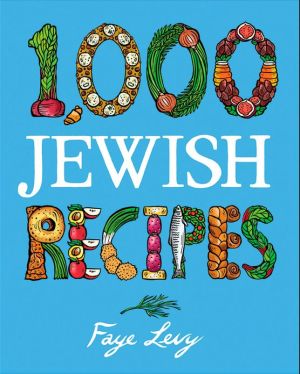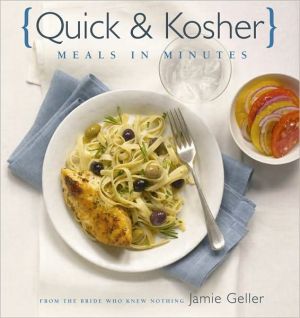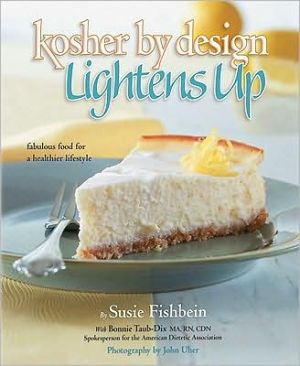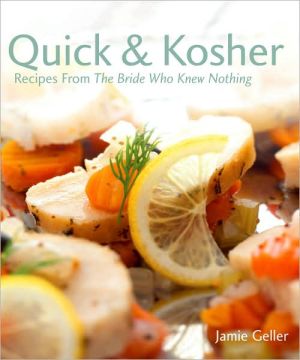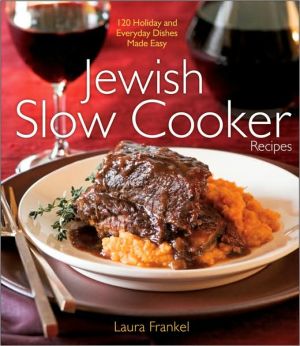1,000 Jewish Recipes
A celebration of Jewish kosher cooking and tradition\ This expert cookbook offers all the recipes and information any cook needs to celebrate Passover, Rosh Hashanah, and many other Jewish holidays. 1,000 Jewish Recipes includes instructions for maintaining a kosher kitchen, information on the delicious culinary heritage of Jewish cultures, and tempting and easy-to-follow recipes such as Three-Cheese Knishes and Old-Fashioned Roast Chicken.
Search in google:
1,000 Jewish Recipes Are you cooking for the Jewish holidays and don't know what to serve or want to serve something new? Do you need inspiration for everyday kosher meals? If you want to cook delicious Jewish foods, 1,000 Jewish Recipes provides all the recipes and information you need—to celebrate Rosh Hashanah, Passover, Hanukkah, and many other holidays; to enliven Shabbat meals; and to create memorable dishes for family and friends any time. You'll find recipes for every occasion, plus information on the culinary origins of Jewish foods, how to keep a kosher kitchen, and how to stock your pantry. Award-winning cookbook author Faye Levy offers you a collection of Jewish recipes unmatched by any other. Her recipes reflect authentic flavors and traditions while being straightforward and easy-to-follow. There are clear descriptions of ingredients and methods, plus useful suggestions for substituting ingredients, saving time, or making recipes more healthful. Each recipe also features at-a-glance kosher symbols: M for Meat, D for Dairy, or P for Pareve. No matter what the occasion, there are wonderful recipes to explore. There are comforting classics such as: Matzo Ball Soup, Cheese Blintzes, Classic Matzo Brei, Friday Night Chicken, Cholent with Brisket, and Old-Fashioned Coffee Cake. You'll also find countless new temptations from around the world such as: Israeli Salad with Early Summer Herbs, Roman Fish with Pine Nuts and Raisins, Moroccan Cigars, Polish Cucumbers in Sour Cream, Tunisian Tuna and Pepper Salad, and Indian Vegetable Tzimmes. Faye Levy's knowledge of Jewish cooking offers you such riches! You'll find:Six varieties of Passover haroset from Ashkenazic Haroset (with apples and cinnamon) to Persian Pear and Banana HarosetSixteen varieties of latkes from Classic Potato Latkes to Cajun Corn LatkesSix varieties of hummus from Jerusalem Hummus to Country-Style Hummus to Spicy Tomato HummusThirteen varieties of challah from Holiday Honey Challah to Onion-Sesame Braidand much more!Of course, beyond recipes, it is the shared traditions and history that connect people within a family, within a community, and within a culture, enriching the foods we eat. In 1,000 Jewish Recipes, Levy shares cultural insights, religious history, and personal anecdotes throughout the book, to enlighten and inspire you as you cook. Whether you already own Jewish cookbooks or this will be you first, 1,000 Jewish Recipes is the cookbook you can't do without. New York Times - Florence Fabricant It's not a stretch to call Faye Levy's 625-page volume, "1,000 Jewish Recipes," a culinary bible. It may be the only Jewish cookbook you'll ever need.Ms. Levy, who has written a number of reliable cookbooks, both kosher and nonkosher, alternates between Sephardic, or Mediterranean and Middle Eastern, dishes and the Ashkenazic cuisine of Northern Europe and Russia, explaining the characteristics of each style. She takes advantage of the luxury she has in this volume to unbutton her rich creativity and offer variation upon variation for classic dishes.
\ \ \ \ \ Chapter One\ The springtime festival of Passover takes place in late March or in April and lasts for eight days. The Seder, the ceremonial holiday dinner, is prepared on the first and second nights of the holiday, except in Israel, where there is a Seder only on the first night.\ Perhaps the best-known passage about the holiday is the question recited by all Jewish children as part of the Seder, "Why is this night different from all other nights?" The standard response delineated in the Haggadah, the Seder book of readings, prayers, and songs, is that Passover commemorates the liberation of the ancient Hebrews from slavery in Egypt.\ A more offhand answer to this question might be, "because the food is different." The kitchen, and indeed the entire house, undergoes extensive preparation and cleaning for the holiday. Certain foods are avoided during the holiday or even completely removed from the house.\ Naturally, in observant families, food for Passover must be kosher. In addition, it has to be Kosher-for-Passover. The Hebrew word for food that is not kosher for the holiday is hametz, or leavening, because the Torah prohibits eating leavened bread during the holiday to recall the flat bread the Hebrews ate during their flight from Egypt, when they could not wait for their bread to rise.\ This flat bread was the first matzo. It has become the symbol of Passover and is served not only as bread, but is also used to make a variety of other foods, from dumplings to cakes.\ Matzo is ground and made into matzo meal,which is used in cooking and baking instead of raw wheat flour, which can leaven naturally when combined with liquid and is thus not allowed during the holiday. Cake meal, a finer version of matzo meal, is used to make sponge cakes and other light cakes.\ In Ashkenazic and some Sephardic communities, other types of grains and beans are avoided as well. These are grouped under the term kitniyot, Hebrew for legumes, which is used in a broad sense to include corn, rice, other grains, beans, peas, and sesame and sunflower seeds. Other foods derived from these are also not used, including cornstarch and corn oil.\ Despite these restrictions, Passover is not at all an occasion for deprivation. The opposite is true; in the recipe repertoires of many families, the greatest number of favorite dishes and desserts are Passover ones.\ When I was growing up, the number of Passover foods was limited. Now markets feature a dizzying array of foods with Kosher-for-Passover labels. This is true not only of kosher grocery stores but also supermarkets in neighborhoods with a substantial number of Jewish residents.\ Old-fashioned macaroons, once known only in classic almond or coconut flavors, come in many new varieties like chocolate-mint and cinnamon-pecan. Also, now, not only macaroons are sold and served at Passover, but also biscotti and chocolate chip cookies, plus a great variety of cakes and cookies, including coffee cake, rugelach, and cinnamon rolls— things we never used to have for the holiday. There are Passover noodles and even pizza dough mix. Passover equivalents of popular breakfast cereals are also available, instead of just farfel, the little squares of matzo we ate as cereal as children.\ I still love farfel for breakfast, and I understand those friends of mine who feel that using the new foods takes away from the special taste of the holiday. I am glad to have the choice, however. There is still plenty of cooking and baking to be done for that homemade taste, and it can be convenient to keep a few prepared foods on hand in case extra treats are needed.\ \ \ Passover Preparations\ \ \ Before the holiday, to get the kitchen ready, the oven, burners, refrigerator, and sink need to be cleaned thoroughly. Passover sets of dishes, flatware, cooking utensils, and pots, one for meat and one for dairy foods, replace the ones used during the rest of the year. Some utensils can be kashered, or made suitable for Passover by being scalded with boiling water; specifics on this procedure can be obtained from a rabbi.\ Food staples that are hametz, or not kosher for Passover, are handled in different ways. Some people use up these foods before the holiday. Hametz products may also be locked in a cabinet for the duration of the holiday. The local rabbi symbolically "sells" this food to a person who is not Jewish and "buys back" the food after the holiday. Some families officially authorize the sale and purchase of the food, while in other families it is understood that the rabbi handles the transaction for them.\ Finally the house is checked to be sure there are no bread crumbs. In a ceremony known as "inspecting for hametz," on the night before Passover, the head of the household checks the house for bread crumbs with a candle. If he finds any, the next morning they are burned, outdoors, in areas where local laws allow this. Some people might also include in the burning some hametz foods such as bread or cereal for this symbolic ritual.\ \ \ Special Seder Foods\ \ \ The day before Passover is spent cooking for the Seder and preparing the symbolic items for the Seder plate. This plate is often beautifully decorated and contains labeled sections for each food. The best known of these is the tasty haroset, a sweet and spicy spread made of fruits and nuts, of a reddish-brown color to represent the mortar and bricks the Hebrew slaves made in ancient Egypt. To recall the bitter lives led by the slaves, there is Maror, or bitter herbs, which can be fresh horseradish or bitter greens.\ Beitza, a roasted hard boiled egg, and Zeroah, a roasted lamb bone or poultry neck, appear on the plate to recall the animals brought to the High Priest at the Holy Temple in Jerusalem in ancient Israel for the Passover sacrifice. Karpas, a celery stalk or a parsley sprig, reminds us that Passover is the Festival of Spring.\ A separate plate contains the three matzos that will be eaten during the ceremonial part of the Seder. They are covered with a decorative matzo cloth.\ \ \ The Tasting Ceremony During the Seder\ \ \ Four glasses of wine is the traditional portion served to each person to drink during the Seder. The wine can be sweet or dry but must be kosher for Passover. In some families grape juice is substituted. When I was growing up, we always had sweet wine but our glasses were very small.\ Following the instructions in the Haggadah, the first food to be tasted is Karpas, celery or parsley dipped in salt water. Then a small piece of matzo is tasted. The bitter herbs are tasted alone, then combined with some haroset and matzo.\ Just before the meal, hard boiled eggs are dipped in salt water and tasted. After the meal is served, the children look for the afikoman or afikomen, a Greek-derived Hebrew word meaning a piece of matzo that the head of the household has hidden or that a child has stolen and hidden; the one who finds it gets a present. There are numerous explanations of what this broken matzo and its hidden half represent—the extreme poverty of the slaves in Egypt, the messiah who is yet to come, and the future redemption of the unfree, are a few. Some attribute a more practical rationale for hiding the matzo—this game keeps the children awake during the Seder. Tasting the afikoman is the last food of the Seder.\ \ \ Cooking for the Seder\ \ \ The Seder is a multi-course feast. After sitting at the dinner table and reading the Haggadah, which can take several hours, everyone is really hungry! Since you can't always know exactly how long the reading and chanting will take, it's convenient to plan a Seder menu of dishes that can be prepared ahead. For this reason, soups and braised dishes are traditional choices.\ Chicken soup with matzo balls is a Passover favorite in many Ashkenazic families. In my family we love very light matzo balls made without chicken fat.\ For a main course, I like to serve roasted or braised chicken or turkey. When I make a sauce or gravy, I thicken it with potato starch, the most important "flour" allowed for Passover for thickening sauces. Matzo stuffing is a popular accompaniment in our family.\ I like to balance these hearty, old-fashioned foods with light, healthy fresh ones, including plenty of salads. Asparagus often finds its way into our menus as a side dish. This is in keeping with the theme that Passover is the "Festival of Spring."\ Despite the restrictions on flour, Jewish cooks have developed an incredible variety of Passover desserts over the ages. Cakes, cookies, brownies, and pies are made using special Passover products. They don't taste exactly like those made during most of the year, but that is part of the reason they are appreciated.\ The best known cakes are flourless nut cakes and sponge cakes. Macaroons and meringues are the traditional cookies. I love making these at home, although they are widely available in cans. To me, the flavor of these homemade treats is much better.\ For specific Passover menu suggestions, see Menus, page xviii.\ \ \ New Passover Celebrations\ \ \ Celebrating Passover is very much a part of modern Jewish life. In some homes, celebrating the holiday has evolved into a time to get together for a family vacation. When I was in Paris, travel company advertisements proposed that families return to their Jewish roots in Morocco and Spain to celebrate Seders in those countries. American Jews might travel to such resort destinations as Las Vegas or participate in a Hawaiian "Passover in Paradise." In Israel several of my family members celebrate with a week-long Passover vacation in a luxurious hotel. The timing makes perfect sense; after all, Israeli children are on vacation during the holiday.\ \ \ * Haroset\ \ \ Haroset is a sweet mixture of fruit, nuts, and spices prepared for the Seder, the ceremonial Passover dinner that commemorates the exodus of the Israelites from Egypt. It is one of the special foods that appears on the ritual Seder plate. Haroset has a reddish-brown color to recall the mortar and bricks which the Hebrew slaves were forced to make during the days of the Pharaohs. During the Seder, the haroset is tasted along with grated fresh horseradish, of which the bitter taste is a reminder of the harshness of slavery.\ In spite of these somber memories, haroset happens to be delicious and is the best-loved of the Seder foods. Children look forward to it as one of the treats of the holiday.\ As an essential element of the Seder plate, haroset is one of the few dishes made by Jews around the world. Different Jewish communities and families within these groups have different recipes.\ The Ashkenazic haroset recipe is a mixture of apples, walnuts, and wine. Sephardic (Mediterranean and Middle Eastern) Jews tend to favor dried fruits, especially dates, which give the haroset a rich texture and intense fruit taste. Jews from Iran add bananas. Popular nuts among Sephardic Jews are almonds and pine nuts.\ \ \ Ashkenazic Haroset\ \ \ Makes 8 servings [P]\ \ \ When I was growing up, we made our haroset like this, with plenty of apples and walnuts and a touch of sugar, wine, and cinnamon. It is light-textured and very task. Be sure to use good-quality fresh walnuts. Serve haroset with matzos.\ \ \ ¾ to 1 cup walnuts\ 2 to 3 tablespoons sugar\ 2 or 3 large apples, peeled, halved, and cored\ 1 teaspoon ground cinnamon\ 2 to 4 tablespoons sweet red wine\ \ \ 1. Grind walnuts with 2 tablespoons sugar in a food processor until fairly fine, leaving a few small chunks. Transfer to a bowl.\ 2. Grate apples on large holes of a grater. Add to nut mixture. Stir in cinnamon. Gradually stir in enough wine to make a thick spread. Add more sugar if desired.\ 3. Spoon into a serving bowl. Serve at room temperature or cold, as a spread with matzos.\ \ \ Sephardic Haroset\ \ \ Makes about 8 servings [P]\ \ \ Dates give Sephardic haroset its characteristic flavor and color, but dried apricots or other dried fruit might be included. The haroset often contains a small amount of apple as well, as in this version, but the apple is not as dominant as in Ashkenazic style haroset. Sugar is not needed because there is enough natural sweetness in the dates, apple, and wine.\ \ \ 8 ounces pitted dates, coarsely chopped\ ½ cup almonds, coarsely chopped\ 1 sweet apple such as Golden Delicious or Gala, peeled, halved, and cored\ 1 teaspoon ground cinnamon\ 2 to 4 tablespoons sweet red wine\ ½ cup toasted pine nuts (optional)\ \ \ 1. Halve dates and remove any pits or pit fragments. Put dates and almonds into a medium bowl.\ 2. Grate apple on large holes of a grater. Add to date mixture. Stir in cinnamon, then gradually stir in enough wine to make a thick spread. Spoon into a serving bowl. If using, garnish with toasted pine nuts. Serve at room temperature or cold, as a spread with matzos.\ \ \ Note: Toasting nuts at home is easy. For small amounts, a toaster oven is most convenient. To toast pine nuts, preheat oven or toaster oven to 350°F. Toast pine nuts in oven 3 minutes or until lightly browned. Remove to a plate.\ \ \ Yemenite Haroset\ \ \ Makes 10 to 12 servings [P]\ \ \ Like most Yemenites, my mother-in-law always has a jar of "coffee spice," a mixture of cinnamon, ginger, cloves, and cardamom, for adding to dark Turkish coffee. These same spices also give an exotic taste to Yemenite haroset. Sweet and concentrated, it is made primarily of dates, other dried fruits, and nuts and does not contain apples or other fresh fruits. Some people add toasted sesame seeds.\ \ \ ½ cup almonds\ 1/3 cup walnuts\ 8 ounces pitted dates\ ½ cup raisins\ 1½ teaspoons ground cinnamon\ Pinch of ground cloves\ ¼ teaspoon ground ginger\ ¼ teaspoon ground cardamom\ Pinch of freshly ground pepper\ 2 to 4 tablespoons sweet red wine or water\ \ \ Finely chop almonds and walnuts in a food processor almost to a powder. Remove nut powder from the processor, then finely chop dates and raisins. Combine chopped nuts with chopped fruit in a bowl. Stir in spices. Gradually stir in enough wine or water to make a thick spread. Serve at room temperature or cold, as a spread with matzos.\ \ \ Haroset with Orange Juice\ \ \ Makes 8 servings [P]\ \ \ This is a chunky, sweet, fresh-tasting haroset, made of chopped apples and two kinds of nuts. To give it an Israeli accent, you can also add chopped dates, diced bananas—a secret of Israeli mothers to ensure that the haroset will appeal to the children—and a touch of cinnamon.\ \ \ ½ cup hazelnuts\ ½ cup walnuts or pecans\ 3 to 4 tablespoons sugar\ 2 large apples, peeled, halved, and cored\ 3 tablespoons sweet red wine\ 2 tablespoons orange juice\ Grated rind of ½ orange\ \ \ Grind hazelnuts and walnuts with sugar in a food processor until fairly fine, leaving a few small chunks. Transfer to a bowl. Chop apples in food processor or with a knife until fine. Add them to nut mixture. Stir in wine, orange juice, and grated rind. Serve at room temperature or cold, as a spread with matzos.\ \ \ Haroset Truffles\ \ \ Makes 10 to 12 servings of a few truffles each [P]\ \ \ When I attended a Seder in Paris, where most of the guests were of Moroccan origin, the haroset was served in little balls, rather like chocolate truffles. These are good not only at the Seder but also as a tasty, natural treat with a rich, slightly spicy flavor.\ \ \ 8 ounces pitted dates\ ½ cup pecans\ ½ cup almonds\ About 3 tablespoons sweet red wine\ 1 teaspoon ground cinnamon\ ½ teaspoon ground ginger\ 1 sweet apple such as Golden Delicious or Gala, peeled and cored\ \ \ 1. Halve dates and remove any pits or pit fragments. Finely chop pecans and almonds in a food processor and remove to a bowl. Add dates, 3 tablespoons wine, and spices to processor and grind until fairly smooth. Mix with nuts. Grate apple on large holes of a grater. Stir into date mixture. If mixture is dry, add more wine by teaspoons.\ 2. Roll haroset between your palms into small balls of about ¾- or 1-inch diameter. Serve in foil or paper candy cups.\ \ \ Persian Pear and Banana Haroset\ \ \ Makes 8 servings [P]\ Like many Sephardic Jews, Iranian Jews like their haroset flavored with dates. Some add bananas and pears as well. Seasonings are exotic, and might include saffron or cardamom.\ \ \ ½ cup pecans\ 2 to 3 tablespoons sugar\ 1 apple, peeled, halved, and cored\ 2 to 3 tablespoons sweet red wine\ ¾ teaspoon ground cinnamon\ ½ teaspoon ground ginger\ ¼ teaspoon ground nutmeg\ ¼ teaspoon ground cardamom (optional)\ ½ cup almonds, coarsely chopped\ 12 pitted dates, coarsely chopped\ 1 pear\ 1 banana\ Pine nuts (for garnish)\ \ \ 1. Grind pecans with 2 tablespoons sugar in a food processor until fine. Grate apple on large holes of a grater into a bowl and add 2 tablespoons wine. Stir in ground nuts, spices, almonds, and dates. Peel and finely dice pear and banana and add to bowl. Taste and add more sugar or wine, if desired.\ 2. To serve, spread on a flat dish and decorate with pine nuts. Serve at room temperature or cold, as a spread with matzos.\ \ \ Passover Pyramids\ \ \ Makes 16 little pyramid sandwiches [P]\ \ \ These are pyramids of matzo and haroset. In the Seder, haroset serves as a reminder of the mortar that the slaves used to build the pyramids. In this recipe the haroset is the mortar that holds together the miniature matzo pyramids. Eating a sandwich of matzo and haroset is a custom of the Seder. This is a new and fun way to present these sandwiches. The haroset in this recipe is also delicious on its own.\ \ \ 12 ounces pitted dates\ ¾ cup almonds\ ¾ cup walnuts\ About 6 tablespoons sweet red wine\ 1½ teaspoons ground cinnamon\ 1½ teaspoons ground ginger\ Small pinch ground cloves\ 2 small sweet apples such as Golden Delicious or Gala, peeled, halved, and cored\ 12 square matzos\ 16 toasted almonds or walnuts (for garnish)\ \ \ 1. Halve the dates and remove any pit fragments. Finely chop almonds and walnuts in food processor, then remove to a bowl. Add dates, 4 tablespoons wine, and spices to processor and grind until fairly smooth. Mix with nuts. Grate apples on large holes of a grater and stir into mixture. Gradually add wine by teaspoons, if necessary, to make a mixture that is spreadable but still thick.\ 2. To make 16 pyramids, briefly dip 4 matzos one by one in a pan of cold water. With a sharp knife, cut these matzos in 3-inch squares. Put them on a plate. Dip 3 matzos in water and cut them in 2-inch squares. Then, dip 2 matzos in water and cut them in 1½-inch squares. Put them on a plate. Last, dip 2 more matzos in water and cut them in 1-inch squares. Put them on a plate. You will need 16 of each size of squares. Let squares stand for a few minutes to dry slightly so they become easier to handle.\ 3. Spread squares gently with haroset. For each pyramid, use a 3-inch square as a base, top with a 2-inch square, then a 1½-inch, and finally a 1-inch square. Top each pyramid with a toasted almond or walnut.\ \ \ * Salads and Soup\ \ \ Beet and Baby Lettuce Salad with Jicama\ \ \ Makes 4 servings [P]\ \ \ Beets are a favorite on the Passover menu in many homes. We love serving them this way, in a salad with baby greens, and an added California touch—sweet crunchy jicama and a lime juice dressing.\ \ \ 2 large beets, rinsed\ 2 quarts mixed baby lettuces, washed and dried\ 3 cups peeled diced jicama\ 2 tablespoons lime juice\ 2 to 4 tablespoons walnut oil or vegetable oil\ Salt and freshly ground pepper, to taste\ 1/3 cup toasted mixed nuts\ \ \ 1. Put beets in a pan, cover with water, and bring to a boil. Cover and simmer over low heat 40 to 50 minutes or until tender. Let cool. Run beets under cold water and slip off the skins. Cut beets into wedges.\ 2. In a large bowl combine lettuces and jicama, and toss. In a small bowl, whisk lime juice, oil, salt, and pepper until blended. Pour over greens mixture and toss thoroughly. Taste and adjust seasoning. Serve greens topped with beets and sprinkled with nuts.\ \ \ Artichokes with Spicy Lemon-Herb Dressing\ \ \ Makes 4 servings [P]\ \ \ Artichokes are a Passover favorite in the French-Jewish and Sephardic kitchens. This is an easy, flavorful way to serve them.\ \ \ 4 medium or 8 small artichokes\ 2 tablespoons strained fresh lemon juice\ Salt and freshly ground pepper, to taste\ 5 or 6 tablespoons extra-virgin olive oil\ 2 teaspoons fresh thyme or 1 teaspoon dried\ ½ to 1 teaspoon minced jalapeño pepper, or to taste\ 1 to 2 tablespoons chopped fresh Italian parsley\ \ \ 1. To trim artichokes: cut off top 1 inch of large artichokes or ½-inch of small ones. Trim spikes from tips of leaves with scissors.\ 2. Put artichokes in a large saucepan of boiling salted water and cover with a lid of slightly smaller diameter than that of the pan to keep them submerged. Cook over medium heat until a leaf can be easily pulled out; medium artichokes will need about 30 minutes and small ones 15 to 20 minutes.\ 3. To make dressing: whisk lemon juice with salt and pepper. Whisk in oil, thyme, and jalapeño pepper. Taste and adjust seasoning. Before using, whisk dressing and add chopped parsley.\ 4. Using tongs, remove artichokes from water, turn them upside down, and drain thoroughly. Either cover to keep warm or let cool and serve at room temperature or chilled. Serve dressing on the side.\ \ \ Springtime Green Salad with Passover Nuts\ \ \ Makes 4 servings [P]\ \ \ When my husband was growing up in Israel, hazelnuts were known as "Passover nuts," and he still often refers to them by this name. A sprinkling of hazelnuts lends a festive touch to this salad. We toast the hazelnuts for richer flavor but you can use them raw in the salad if you like.\ For the greens, I often use chopped romaine lettuce hearts mixed with tender butter lettuce or crunchy iceberg lettuce. Another terrific choice is mixed baby greens. Sliced red radishes and thin slivers of mild onions—either sweet onions or red onions—give pleasing accents of taste and color.\ \ \ ¼ cup hazelnuts\ 4 cups romaine lettuce\ 2 cups butter lettuce (Boston lettuce)\ 1 cup iceberg lettuce\ 4 to 6 baby radishes, cut into thin slices\ ¼ sweet onion, cut into thin slivers\ 3 to 4 tablespoons Passover Vinaigrette (page 10)\ \ \ 1. To toast the hazelnuts, preheat oven to 350°F. Toast hazelnuts in a shallow baking pan in oven about 8 minutes or until skins begin to split. Transfer to a strainer. Rub hot hazelnuts with a towel against strainer to remove some of skins. Cool nuts on a plate.\ 2. Tear or cut lettuces into bite-size pieces or larger. Mix lettuces, radishes, and onion in a serving bowl. Just before serving, add dressing, and toss until greens are moistened. Taste and adjust seasoning. Serve salad sprinkled with nuts.\ \ \ Passover Vinaigrette\ \ \ Makes 7 or 8 tablespoons [P]\ \ \ Olive oil is the best choice for vinaigrette, and not only for reasons of taste. Many vegetable oils are not kosher for Passover, as they might contain corn oil, soy oil, or other types of oil that are avoided during the holiday. Wine vinegar that is kosher for Passover is widely available in supermarkets and at kosher markets.\ \ \ 2 tablespoons red or white wine vinegar\ Salt and freshly ground pepper, to taste\ 5 to 6 tablespoons extra-virgin or other olive oil\ \ \ Whisk vinegar with salt and pepper in a small bowl. Whisk in olive oil. You can multiply this dressing as you like and keep it in a jar in the refrigerator. Shake or whisk before using.\ \ \ Passover Chicken Soup with Matzo Balls\ \ \ Makes 6 to 8 servings [M]\ \ \ Matzo ball soup undoubtedly originated as a Passover specialty, because the kneidelach, or dumplings, are made from matzo meal. It became so popular that it is a standard on the Shabbat table in many homes. Our family enjoys it not only for Shabbat, but also for most holidays. Indeed, some people want to be able to feast on this savory soup any day of the year and therefore it is one of the best-loved items on deli menus.\ Passover matzo balls are made without baking powder because no leavening is allowed. I like to give the soup a springtime accent with plenty of fresh parsley from my garden and occasionally some baby carrots or asparagus.\ \ \ 2 pounds chicken pieces\ 10 cups cold water\ 1 whole onion, peeled\ 2 ribs celery, including leafy tops\ 1 bay leaf\ 5 sprigs fresh parsley\ Salt and freshly ground pepper, to taste\ ½ pound baby carrots, peeled\ 3 large eggs\ 1 cup matzo meal\ About 2 quarts salted water (for simmering the matzo balls)\ 3 tablespoons chopped fresh parsley\ \ \ 1. Combine chicken, water, onion, celery, bay leaf, parsley sprigs, and a pinch of salt in a large saucepan and bring to a boil. Skim thoroughly. Partially cover and simmer 1½ hours, skimming occasionally. Add carrots and simmer about 15 minutes or until tender. Skim off excess fat. Chicken soup can be kept 3 days in refrigerator; skim fat again and reheat before serving. Add pepper and taste for seasoning.\ 2. To make matzo balls: Lightly beat eggs in a small bowl. Add matzo meal and a pinch of salt and pepper and stir with a fork until smooth. Gradually stir in 2 to 4 tablespoons chicken soup, adding enough so mixture is just firm enough to hold together in rough-shaped balls.\ 3. Bring salted water to a bare simmer. With wet hands, take about 2 teaspoons of matzo ball mixture and roll it between your palms into a ball. (Mixture will be very soft.) Gently drop matzo ball into simmering water. Continue making balls, wetting hands before shaping each one. Cover and simmer over low heat 30 minutes. Cover to keep them warm until ready to serve.\ 4. When serving, skim fat again from soup. Discard onion, celery, bay leaf, and parsley sprigs. Reheat to a simmer. Remove from heat and add chopped parsley.\ 5. For each serving, remove 2 or 3 matzo balls from their cooking liquid with a slotted spoon, add them to soup bowls, and ladle hot soup over them. Serve hot.\ \ \ Note: If the soup is hot, skim the fat from its surface with a large spoon. To remove the last bits of fat, you can dab the surface with a double thickness of paper towels; this must be done quickly so the towels won't disintegrate into the soup. The fat can be skimmed off most easily if the soup is first refrigerated. As the soup cools, the fat rises to the top and solidifies. The fat can be scraped off the cold soup's surface with a spoon.\ \ \ Zucchini Soup with Passover Croutons\ \ \ Makes 4 servings [D]\ \ \ Instead of being thickened with flour, this light, thyme-scented soup gains its body from a puree of zucchini and onion. The croutons are made of toasted matzo farfel rather than bread.\ \ \ 1 cup matzo farfel\ 2 tablespoons plus 2 teaspoons vegetable oil\ Salt and freshly ground pepper, to taste\ Pinch of paprika\ 1 large onion, halved and cut into thin slices\ 1½ pounds zucchini, unpeeled and sliced\ 1 large sprig fresh thyme or ½ teaspoon dried thyme\ 1 bay leaf\ 1½ cups vegetable broth or water\ ½ cup milk\ 1/3 cup whipping cream or additional milk\ Pinch of cayenne pepper\ \ \ 1. To make croutons: Preheat oven to 350°F. Mix farfel with 2 teaspoons oil and a pinch of salt and pepper in a bowl. Spread on a baking sheet and sprinkle with paprika. Bake, stirring once or twice, about 12 minutes or until lightly browned.\ 2. Meanwhile, heat 2 tablespoons oil in a medium saucepan over low heat. Add onion and cook over medium heat, stirring occasionally, about 10 minutes or until soft but not brown. Add zucchini, thyme, bay leaf, salt, and pepper. Stir over low heat for 2 minutes. Add broth and bring to a boil. Cover and cook over low heat about 10 minutes or until zucchini are very tender. Discard bay leaf and fresh thyme sprig.\ 3. Let soup cool slightly. Pour into blender. Puree soup until smooth. Return soup to pan and bring to boil, stirring. Stir in milk and bring to a simmer. Stir in cream and return to simmer. Add cayenne pepper, taste and adjust seasoning. Serve hot soup with croutons.\ \ \ Passover Soup "Nuts"\ \ \ Makes 8 to 10 servings [P]\ \ \ These delicately spicy baked soup nut-like croutons are sometimes called mandeln, the Yiddish word for almonds, because they are somewhat crunchy. They are good in chicken or vegetable soup.\ \ \ 1/3 cup water\ 3 tablespoons vegetable oil\ ½ teaspoon salt\ 2/3 cup matzo meal\ ¼ teaspoon ground cumin\ Pinch of cayenne pepper\ 2 large eggs\ \ \ 1. Preheat oven to 375°F. Generously oil a baking sheet. Combine water, oil, and salt in a small saucepan. Bring to a boil. Remove from heat and add matzo meal all at once. Mix well. Add cumin and cayenne pepper. Return pan to low heat and cook, stirring, for 1 minute. Remove from heat and cool about 5 minutes.\ 2. Beat in 1 egg. When mixture is completely smooth, beat in second egg.\ 3. With a pastry bag or a teaspoon, drop batter by quarter teaspoons onto greased baking sheet, allowing about ½-inch between them. Bake 20 to 30 minutes or until golden brown and firm.
Acknowledgments.Introduction.The World of Jewish Cooking.A Guide To Keeping Kosher.Stocking the Jewish Pantry.Menus.Passover.Shavuot.Rosh Hashanah and Yom Kippur.Sukkot.Hanukkah.Purim.Shabbat.Appetizers.Salads.Soups.Dairy Specialties Blintzes, and Eggs.Fish.Poultry.Meats.Pareve and Vegetarian Main Courses.Vegetable Side Dishes.Noodles, Couscous, and Other Pasta.Rice and Other Grains.Breads and Yeast Cakes.Desserts, Cakes, and Cookies.Basics.Appendix A: The Jewish Calendar.Appendix B: Glossary.Index.About the Author.
\ Florence FabricantIt's not a stretch to call Faye Levy's 625-page volume, "1,000 Jewish Recipes," a culinary bible. It may be the only Jewish cookbook you'll ever need.Ms. Levy, who has written a number of reliable cookbooks, both kosher and nonkosher, alternates between Sephardic, or Mediterranean and Middle Eastern, dishes and the Ashkenazic cuisine of Northern Europe and Russia, explaining the characteristics of each style. She takes advantage of the luxury she has in this volume to unbutton her rich creativity and offer variation upon variation for classic dishes. \ —New York Times\ \
